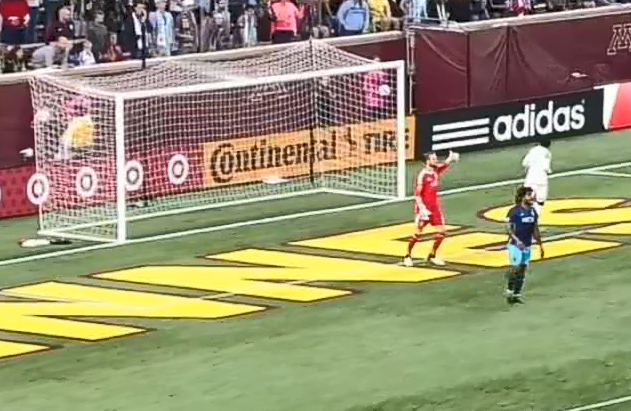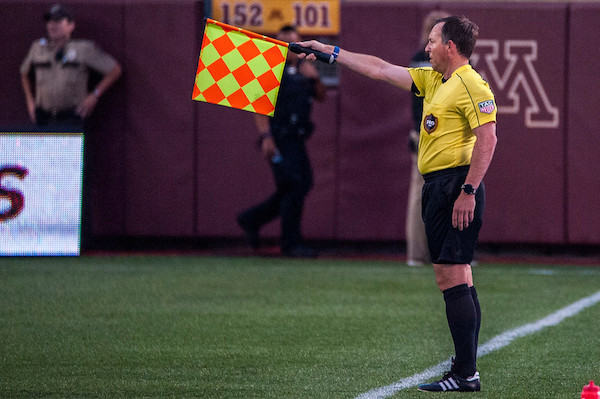For all of the pro/con arguments about Video Assistant Referees (VAR) that have taken place this summer, Saturday’s Minnesota United vs. Seattle Sounders game provided an instance where VAR proved a far more complicating component to the match than likely anybody ever anticipated. To say that video review is going to change the way the game is officiated at the professional level is an understatement. It is rapidly becoming clear that it will change the game in ways that were not anticipated.
In the 12th minute, Kevin Molino played a pretty through-ball for Abu Danladi out of the midfield. Danladi was a bit behind his mark, Román Torres (or as my kids call him, The Weeknd), but Chad Marshall on the backside of the play is behind Torres and may or may not have been keeping Danladi onside. We don’t ever get a replay angle even with Marshall, so the arguments here are strictly geometrical and ultimately inconclusive. Or, perhaps conclusive if you refuse to eliminate bias for either team. I don’t really want to spend a lot of time on that element of the play.

Assistant referees are generally advised to err on the side of the attacker in these situations. If there is any doubt that the attacker is offside, the flag should stay down. The assistant referee on this play, Adam Garner, shows terrific mechanics and positioning to put himself in the best place to make the correct decision, but Marshall’s sudden drop is very difficult to anticipate (and also some really poor positional defending… Marshall played really well the rest of this night, but this was not his finest moment). Garner was 100 percent sure Danladi was still offside when Molino played the through-ball. Danladi’s foot or torso had to be beyond Marshall, hence the flag. But this decision is so tight, if Garner keeps the flag down here and replays show that Danladi’s chest hair or big toe is beyond Marshall, nobody is going to dock him points for the apparent mistake.

The conundrum this play creates for the officiating crew in the Land of VAR (a region most certainly that is going to be annexed by Vladimir Putin at some point in the future) is the ability to review it. Without VAR, the decision falls entirely on Garner. With VAR in play, both Garner and referee José Carlos Rivero have the opportunity to think on their feet and use technology to improve their ability to get this play right — if they follow the rules of VAR.
We saw Clint Dempsey’s first half goal undergo a brief review for an offside decision and the goal was correctly awarded. The VAR review could be implemented because the ball was in the goal and the stoppage before the ensuing kickoff allowed time for a review, to ensure the decision was accurate.
In Danladi’s play, however, when play is stopped in the midfield, there is no opportunity to deploy the VAR. If VAR were to be used and the decision was made that Danladi was onside, the only option would be a dropped ball restart for an accidental whistle. That might restore a slight sense of justice over possession, but Minnesota want Danladi in clean on goal, and that isn’t going to happen. Therefore, as this play was called, it was not reviewable.
But what if Garner, recognizing he has a VAR safety net, decides to keep the flag down here? Danladi rolls through and let’s say he scores. Just like the Dempsey goal, Rivero and VAR Victor Rivas can now review the play and decide if Danladi was offside. If yes, the goal can be overturned and an indirect free kick is awarded to Seattle at the point of the infraction. If no, Minnesota gets a justly deserved goal. If the officiating crew wants to ensure justice is carried out on this play, Garner’s logically correct decision here is to keep the flag down and let play continue.
That decision is not just on Garner. The referee is empowered to overrule any decision by their assistants. Rivero could have thought in that split second, “Wait, that looks really tight, Danaldi is in clean, I can wave down my assistant referee and let the play run. I can always go back to VAR.” Rivero has a second opportunity to recognize the value of the replay review to positively affect the play.
Is PRO or, at a higher level, FIFA, offering this kind of instruction to officiating crews using VAR? I have no idea. If not, I would argue VAR is not being utilized to its fullest extent. The rules of implementation do make sense for how this play was called. If play is halted for the offside infraction, there’s no point in activating VAR, because Minnesota has already lost the scoring chance. In order to provide all possible outcomes, the referee crew has to (a) recognize this call is razor thin and (b) implement a decision-making process that maintains all possible outcomes. The need for the referee and their assistants to think on their feet and recognize the complexity of these decisions just multiplied.
One other interesting outcome of this play is the application of misconduct and the players’ understanding (or lack thereof) of how VAR is implemented. Danladi, in spite of the whistle, continues charging towards goal with the ball and slots it past Seattle goalkeeper Stefan Frei. In the world of unwritten rules of soccer, this has generally been regarded as a no-no, sort of like hockey players who continue skating towards goal after a whistle, then launching a shot past the goalkeeper. Regardless of the sport, goalkeepers don’t like dragging any kind of ball out of their net, good goal or not. Frei is visibly upset by Danladi’s actions. This sort of behavior by Danladi has traditionally warranted a lecture from the referee or even a caution for delaying the restart of play.

VAR changes that. If I’m Danladi, I finish this play because hey, maybe if I score, the VAR can go back and give us the goal! It’s in my and my team’s best interests for me to keep playing here.
Of course, players are expected to know and adhere to the rules of the sport, so one could make a weak argument that Danladi should know that if he plays past the whistle here, there’s no way the play can be reviewed anyway. But this is a brand new and complex mechanic for the sport. It’s going to take some time for players to get used to it. How long do they get? Several months? Several years? Will the International Football Association Board continue to tinker with when and where VAR can be implemented? If it is changing frequently, actions like Danladi’s can no longer be punished as severely as they used to be. Players can “hide” behind the excuse that they are just trying to provide alternate outcomes for the VAR to review.
I am not saying that VAR is a positive or negative addition to the professional game at this point. I think most of its applications will actually turn out to be positive. However, it’s going to change things on levels that have not even been considered yet. One of the challenges with VAR is that, unlike other elements of officiating, there is not going to be an opportunity to practice its use and mechanics at lower levels. A referee can work on player management and presence tactics from the moment they start officiating U-10 games all the way through their promotion to the professional ranks. With VAR, the first time you use it is when you finally crack those professional ranks. In talking down an angry player, a referee can use skills and conversation that they have practiced at lower levels of the game. With complex decisions such as the Danladi play, this is a going to be a brand new experience at the game’s highest level. Whether that is a positive for officiating remains to be seen.
FiftyFive.One is now on Patreon. Do you like the independent coverage of soccer news from Minnesota and beyond that FiftyFive.One offers? Please consider becoming a patron.

Leave a Reply